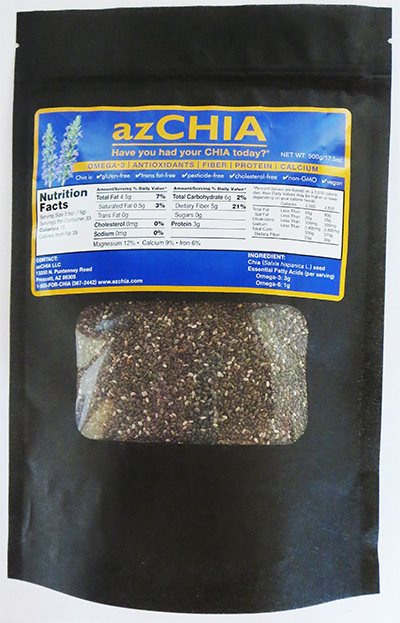 The popular chia seed has a lot going for it – it’s a complete protein, its full of fiber, its high in the anti-inflammatory omega-3 fatty acid alpha linolenic acid (ALA), it’s packed with antioxidants, and chia seeds have a gelatinous quality that makes you feel full without having to eat a lot, so chia seeds can be good for weight loss and blood sugar regulation. Did I mention they are gluten free and vegans can use them as an egg substitute???
The popular chia seed has a lot going for it – it’s a complete protein, its full of fiber, its high in the anti-inflammatory omega-3 fatty acid alpha linolenic acid (ALA), it’s packed with antioxidants, and chia seeds have a gelatinous quality that makes you feel full without having to eat a lot, so chia seeds can be good for weight loss and blood sugar regulation. Did I mention they are gluten free and vegans can use them as an egg substitute???
Here comes the “but.” The person many turn to for the skinny on chia seeds is Loren Cordain, the Colorado State University professor who kicked off the paleo movement in a big way with his 2001 book, The Paleo Diet.
According to Cordain: “On paper, it would appear that chia seeds are a nutritious food that is not only high in ALA, but also is a good source of protein, fiber, certain B vitamins, calcium, iron and manganese. Unfortunately, the devil is always in the details… As is the case with many other plant seeds (e.g., cereal grains, legumes) chia seeds contain numerous antinutrients which reduce their nutritional value … chia seeds are concentrated sources of phytate, an antinutrient that binds many minerals (calcium, iron, zinc, magnesium and copper) thereby making them unavailable for absorption. So, in our bodies, chia seeds actually become inferior sources of all these minerals … the mucilaginous gel that surrounds the seeds forms a barrier which impairs digestion, fat absorption and causes a low protein digestibility. Based upon animal and human studies, it is likely that other antinutrients together with this gel may promote a leaky gut, chronic systemic inflammation and food allergies … Until further human trials are completed employing a sample size with sufficient statistical power to resolve these immune system issues, then the potential adverse effects of long term, chronic chia seed consumption may outweigh the potential benefits.” To read more, click here
And yet, the anthropological evidence is that humans have been eating chia seeds for about 5,000 years. Chia seeds are native to southern Mexico and northern Guatemala, eaten by the Aztecs and other native cultures who grinded them into flour, pressed them for oil, and used chia as a medicine. Chia is the Mayan word for “strength.” Chia seeds were revered for their ability to increase stamina and energy over long periods of time. So if these tiny seeds were a great food then, but not now, what happened? Let’s dig a little deeper.
Look back to 1990 – chia seed wasn’t sold commercially; the chia seed had virtually died out. You could find it only in little markets in Mexico. Along came Dr. Wayne Coates and the rest of the team of the Northwestern Argentina Regional Project. They were tasked in 1991 with finding alternative crops to grow in a region that grew pretty much just tobacco and beans.

“We knew nothing about chia until we started analyzing it in the lab,” Dr. Coates told me. “Then we figured it was worth growing. I don’t know if I would call chia a ‘superfood,’ but it certainly has many great characteristics. It is a complete protein. It’s a great source of omega 3. It has no flavor; you can add it to anything. You can eat it whole, milled, ground, soaked – that’s the beauty of it. Unlike flax, it does not go rancid quickly. The high oil content of its leaves acts as an extremely potent insect repellent and eliminates the need for pesticides being used to protect the crop. There are so many positives. Now, if you have been eating a low fiber diet and start eating chia, you could have diarrhea – that’s a natural reaction to the introduction of substantial fiber.”
Is Professor Coates aware of Professor Cordain’s take on chia? Oh yes.
“Years ago I corresponded with him about it, but he wasn’t open to it so he’s running on generalities. Flax seed has anti-nutritional properties, but not chia. The soluble fiber in chia is very helpful to diabetics because it slows down the glycemic factor. People eating chia have lowered their cholesterol, lost weight, gained energy, and solved joint issues. Chia has been a food for thousands of years.”
And what of the argument that the omega 3 in chia seeds, alpha linolenic acid (ALA), is something the body has a tough time converting?
“The only essential omega 3 is ALA – your body cannot make it,” Dr. Coates explained. “EPA and DHA which come from marine animals are not essential; our body converts (makes) them from ALA. The reason so many people have a problem making the conversion is because they eat way too much omega 6. That’s the omega fatty acid in so many fried and processed foods. The same enzyme the body uses to convert or ‘process’ omega 6s is the same one it needs to convert ALA to EPA and DHA. We should eat about equal amounts of omega 6s and omega 3s, but the standard American diet can deliver, say, 20 times as much omega 6. So if you have used up all your enzymes processing the omega 6s, you don’t have much left over to help you convert that ALA omega 3 to EPA and DHA. The conversion is a problem because of the imbalance of omega 6 in the diet.”
What about flax, the other seed with ALA?
“Flax seed is going to pass right through the body unless you open its hard shell by soaking, grinding, or cooking. That hard seed coat is nature’s way of protecting the omega 3 in flaxseed from going rancid. So you need to grind, cook, sprout, or somehow open the seed so that the digestive process can be effective. If you do not do this, the seeds will just pass through your body. Flax seed also goes rancid quickly so you have to grind it daily. Flax, by the way, has not been in our diet until recently. People historically used it to make linen and such, but they did not eat it.”
Chia, he explained to me, is very different than flax.
“The omega 3 in chia is protected by the natural antioxidants in the seed. You can sprout it if you want to, but there is no research I know of that documents that it makes a difference. You can eat it whole, milled, ground, soaked – that’s the beauty of it. Chia’s omega 3 is stable when it is milled at ambient temperatures. It doesn’t go rancid easily. Our milled chia is good for one year, whole seed for five years.”
 Today, Dr. Coates is retired from the University of Arizona where he specialized in new crop development and mechanization. He sells the AZChia brand and points out that not all chia is worth buying.
Today, Dr. Coates is retired from the University of Arizona where he specialized in new crop development and mechanization. He sells the AZChia brand and points out that not all chia is worth buying.
“Chia seeds are black/gray, and white/cream. (Go here for photos.) Anything else colorwise is immature chia or weed seeds. Sometimes you find a lot of small round completely black seeds. These are weed seeds, not chia as it is an oval, egg shape. Immature seeds will have lower protein, and lower omega 3 content. I’ve even seen weed content in some of the chia that is on the market.”
To watch a really interesting University of Arizona video presentation on chia, go here.
